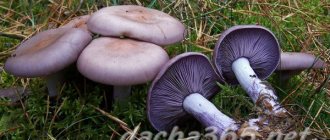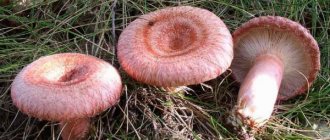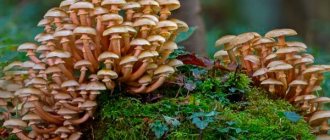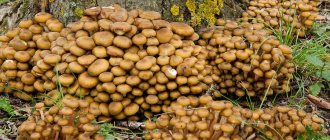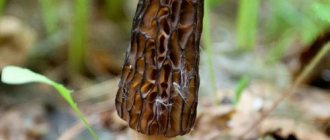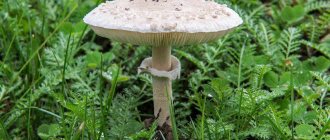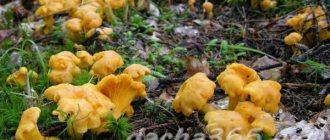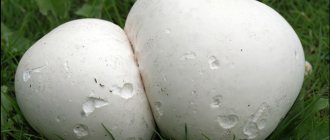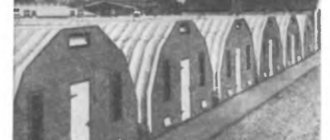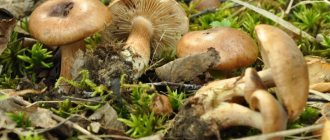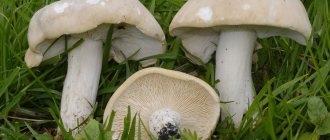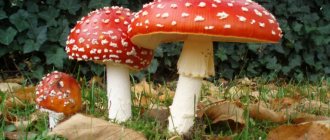Mushrooms
0
1277
Article rating
Kira Stoletova
Mushrooms are a type of organism that does not belong to either the animal or plant world. The taste and beneficial qualities of this product cannot be overestimated. Edible mushrooms in Tyumen begin to be collected with the onset of warm weather in the spring and continue until November.
Mushrooms in Tyumen
general characteristics
A good assistant when harvesting a forest harvest is a mushroom calendar, which tells you which mushrooms are best to look for in spring, summer or autumn.
Before collecting, you should decide what the products will be used for; you need to know their main characteristics. Mushrooms have different tastes and degrees of edibility. Some are better cooked, while others will be much tastier when salted or pickled.
According to their edibility characteristics, all mushrooms are divided into several categories:
- Category 1: edible;
- Category 2: conditionally edible;
- Category 3: inedible;
- Category 4: poisonous.
They, in turn, are divided into groups according to taste characteristics:
- the most fragrant: all types of whites, boletus;
- less aromatic: chanterelles, butterfly mushrooms, etc.;
- with a weak aroma and taste: moss mushrooms, milkweed, etc.
The latter have a pungent taste and unpleasant aroma. They are difficult to process and require long soaking and pre-cooking. In Tyumen they are not touched, because there are a lot of other good mushrooms that can be collected with fewer pre-processing problems.
Before use, mushrooms are carefully sorted, washed and cleaned. Milkworms have their own characteristics, so it is better to collect them if you have a proven cooking recipe.
You should not collect poisonous mushrooms: fly agarics, toadstool, etc.
Types of mushrooms in Tyumen
People go to harvest forests at any time of the year if they know what the edible species look like, which allows them not to be confused with their poisonous or false counterparts.
Spring views
Mushroom pickers go to the forests in early spring. In their favorite places they find the first spring varieties:
- morels;
- lines;
- rows;
- double-ringed champignons;
- raincoats;
- entolomas.
Under certain conditions, strings and morels can accumulate poisons, so they are thoroughly boiled or dried before use.
Morels must be boiled before cooking.
There are several types of morels: conical, edible, tall. The characteristics of this organism are as follows:
- loves sunlight;
- grows in nutrient-rich soil;
- Fruiting lasts from May to June;
- size – from 6 to 15 cm in height.
Description line:
- prefers to grow in coniferous and mixed forests;
- bears fruit in April and May (one species is also found in autumn);
- fruiting body – up to 15 cm in height;
- the cap is wrinkled;
- cap diameter – up to 30 cm;
- the leg is short, thick;
- leg color is white;
- The color of the cap ranges from beige to reddish.
Another spring organism often found in the Tyumen region is the May row. Sometimes it is called Georgievsky. More often it is found on the edges of deciduous forests, in parks and gardens.
The double-ringed champignon (pavement) loves soils rich in organic matter. It is found in the first grass, on the roadsides or in a city park. It appears at the end of May and disappears in June. Its taste is pleasant, the aroma is average. Suitable for food in any form.
Summer views
With the onset of warmth, mushroom pickers already collect other species:
- white;
- boletus;
- boletus;
- boletus;
- Russula;
- honey mushrooms;
- spikelets;
- chanterelles, etc.
Kolosoviki are considered a subspecies of porcini mushrooms. They do not live long and are found under aspen trees. Description:
- thick leg;
- the shape of the leg is cylindrical;
- beige color;
- the cap is dense, thick;
- cap color brown;
- aroma is average;
- at the break, the color changes from white to beige or gray.
Most often they are used immediately after collection. Boletus mushrooms are found next to them, especially after the first rains in June.
Porcini mushrooms are valued for their taste
Russulas are collected en masse at this time of year. They love to grow in birch groves. Description of Russula:
- height – up to 20 cm;
- the caps are wide and flat;
- diameter – up to 15 cm;
- the lower layer of the cap (hymenophore) is lamellar;
- the leg is hollow;
- the aroma is strong;
- the taste is pleasant;
- white leg;
- the flesh is fragile;
- The color does not change when cut.
They are found in the forests of Tyumen from June until the end of autumn.
Autumn views
The end of August and the beginning of autumn is the most favorable period for harvesting. Summer species have not yet disappeared, but autumn species are already appearing. The most commonly collected species during this period are:
- Russula;
- honey mushrooms;
- white;
- boletus;
- saffron milk caps;
- chanterelles, etc.
Chanterelles, appearing on mossy soil in June, like russula, delight mushroom pickers until mid-October.
Irina Selyutina (Biologist):
Chanterelles are classified into a separate family Chanterelleaceae (Cantarellaceae). This was facilitated by the following features in their structure:
- The hymenophore, instead of thin plates characteristic of agaric mushrooms, in chanterelles on the underside of the cap is formed by rather thick forked folds with rounded edges.
- Basidia (structures for sexual sporulation) located on the surface of the folds of pseudolamellae belong to the stal type and are unique to this family.
Chanterelles, like champignons, can be grown industrially, but in this case all the qualities (taste and aroma) are lost, which has become an insurmountable obstacle to introducing them into culture.
Moss mushrooms with their green or brown caps are found until November. Autumn honey mushrooms from one stump can feed a whole company.
Edible mushrooms
Western Siberia is characterized by the growth of a group of mushrooms, consisting of 7 names, known even to beginners and less popular ones, familiar to experienced collectors.
Professional mycologists in the Tyumen region advise looking for porcini and boletus mushrooms in clean forest areas, away from bushes, thickets of nettles, clover, wheatgrass and other weeds.
Interesting: the greatest variety of edible specimens is found at the junction of different forest formations - between the edges of deciduous or coniferous forests, birch forests, clearings, and ravine slopes. The pattern is due to good access to oxygen, greater illumination, and moisture during precipitation.
Let's look at popular edible varieties growing in the forest-tundra and the features by which they can be easily distinguished.
Boletus
The fruiting bodies are white.
They are found more often than oak, yellow-brown and red ones, they have a fleshy dense cap, the broken flesh quickly darkens.
boletus
The intensity of gray and brown shades of mushrooms depends on the tree under which they are found.
The surface is smooth, the cut turns pink in the air.
Saffron milk caps
The cut flesh takes on a greenish color. The brighter the mushroom itself, the greener the rift.
Pinkish waves
They have a concentric pink-white pattern, the cap deepens towards the center, and there is a pleasant resinous smell.
Real milk mushrooms
They grow only in humid, rainy weather, the juice of the cut cap quickly turns yellow, and the aroma is specific, peppery.
Chanterelles
The flesh of ripe mushrooms turns red when pressed, the skin of the cap does not separate, and the stems are without a cavity.
Summer honey mushrooms
The edges of the caps of young specimens are lighter than the middle, the skin is matte, colored brownish, pale orange.
Inedible and poisonous mushrooms
Poisonous mushrooms are deadly
In the forests of Tyumen there are poisonous and inedible species:
- fly agarics;
- toadstools;
- stropharia;
- cobweb;
- gall;
- talker.
Stropharia hemispherical has a slightly strange appearance and is not familiar to everyone. Considered a hallucinogenic species, it grows in moist soils and is sometimes found on manure heaps.
Irina Selyutina (Biologist):
Stropharia hemisphericus belongs to the genus Stropharia of the same name and the family Strophariaceae. The mushroom got its name from the shape of its cap, which never opens. They are found from mid-summer almost until late autumn on manured soil or even just on manure. Stropharia is characterized by the presence of psilocycin in its pulp, which allows it to be classified as a group of hallucinogenic mushrooms. Despite the fact that the psilocycin activity of the mushroom is insignificant, and sometimes it is absent, the mushroom cannot be considered safe, because Psilobicin causes psychological dependence.
The reddened fly agaric is distinguished by a colorful cap on which there are white spots. Sometimes this species reaches large sizes. The mushroom is not eaten because of the poison.
The most poisonous is the toadstool. Many people die from its toxins. Outwardly, it looks like a honey fungus, the only difference is the skirt with a leg. When harvesting, you need to carefully inspect all specimens, because a single toadstool that ends up in a basket can ruin the entire harvest.
Application of mushrooms
The use of fruiting bodies is not limited to everyday cooking; they have received a wide range of applications in medicine, the production of expensive blue cheese (noble mold, including special types of penicillium), and exotic alcoholic beverages.
Contrary to the opinion of nutritionists that mushroom dishes do not have energy value, scientists have found a high concentration of vitamins A, B1, B2 in edible boletaceous species. This means that food with the addition of boletus prolongs the youth of the skin, improves vision and the condition of the nervous system.
Microscopic doses of cyclosporine in pharmacology help cope with the increased immunological reaction of the body during organ transplantation. The source of this valuable substance is a soil fungus belonging to the species Tolypocladium inflatum.
Cephalosporin, a well-known antibiotic, is used as a powerful statin, a substance that lowers the level of bad cholesterol in the blood. This compound was first isolated in 1948 from fungi of the genus Cephalosporium. To date, the fourth generation of this antibiotic has already been obtained.
“Domesticated” forms, for example, kombucha or muer (Chinese black tree mushroom), are deservedly considered antioxidants that can protect the body from emerging inflammatory processes and serious diseases.
The familiar word “muer” is not scientific. It comes from the Chinese name for the fungus auricularia auriculata - “hei mu er”, which translates as “black tree ear”. In the Russian language, only a part of it has been fixed, giving this name to another species in everyday life - the densely haired auricularia, although it is the ear-shaped one that is more widely used. They belong to the genus Auricularia.
In addition to the black form of muer, yellow and white (dessert) forms are known. Whites can most often be bought dried in Russian supermarkets.
Growing muer at home, according to a number of experts, is not very difficult, but still requires certain skills.
Mushroom places
To go to the forest, take a basket, sandwiches, water and a map of mushroom places.
- Chervishevsky tract: on it, 15 km from the city, there are good mushroom places with porcini mushrooms, especially in the area of the Sibir sanatorium. Traditionally, boletuses and boletuses are collected here. If you drive a little further, up to 9 km, there will be fewer people and more mushrooms.
- Lake Mullashi, Yalutrovsky tract: near the turn to this lake, just 25 km from Tyumen, there are a lot of saffron milk caps and redfish. Boletuses grow near the road to the village.
- Subbotino village, Malkovo village: on the hillocks in these settlements there are many places for collecting porcini mushrooms. Having traveled a little further from the city, towards the village of Krivodanovo, you will be able to reap a good harvest. On the side of the summer camps there are a lot of saffron milk caps and russula.
- The Old Tobolsk Highway: on the way to it, 40 km from Tyumen, they collect a lot of redheads, whites and butterfish. It is better to get there by your own car. They drive to the village of Bogandinsky, focusing on the village of Zhelezny Perbor. There is an asphalt road going here. Then they drive along the dirt road to the village of Novoatyalovo.
- 20 kilometers from the city towards the highway: famous for its scatterings of porcini mushrooms. But the places here are remote, so it’s better to go with a guide.
When does the porcini mushroom season end?
There is no specific harvest date for porcini mushrooms. The first of them appear in mid-June. The season ends with real night frosts, which means it can last until the end of October. If the air temperature rises early, boletus mushrooms can be found in May.
Interesting materials:
What kind of lighting appeared on city streets at the end of the 19th century? What is the distance between poles in the city? What date is City Day in Dneprodzerzhinsk? What city is the zip code 420306? What kind of city is in German? What even more famous city was founded by Yuri Dolgoruky? What city is closest to St. Petersburg? What city was in the place of St. Petersburg? What was the first city in the world? Which city was the capital of Armenia before Yerevan?
